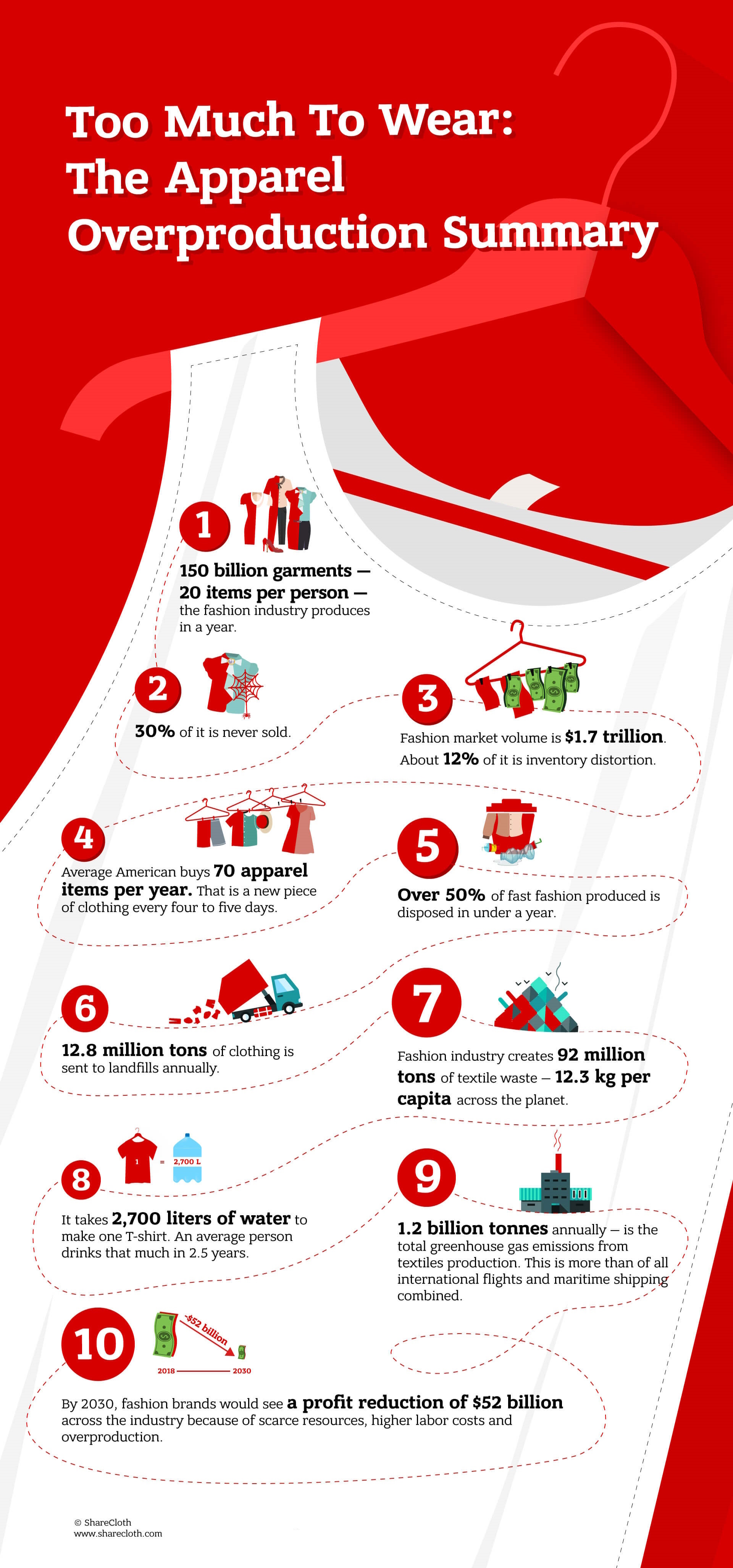The Apparel Industry Overproduction Report & Infographic
Apparel Industry Overproduction Report and Infographic: In this report, you’ll find all you need know about the scale, causes and consequences of overproduction. Created by ShareCloth.
In this in-depth report, brought to you by ShareCloth, we unveil the startling reality of overproduction within the apparel industry. This pressing issue is responsible for growing stockpiles of unsold clothing, environmental degradation, and economic challenges. We have meticulously curated essential data from various sources to provide you with the most up-to-date and comprehensive insights into the scale, root causes, and far-reaching consequences of overproduction in the fashion world.
Facts and Figures
The apparel industry's overproduction quandary is glaringly evident in recent news about major fashion brands. Take, for instance, H&M; - a fashion giant confronted with an astounding $4.3 billion worth of unsold inventory. So colossal is their production that a Swedish town, Vasteras, partially relies on incinerating H&M;'s defective products to generate energy, torching 15 tons in 2017. Luxury brand Burberry also admitted to incinerating products valued at $37 million rather than selling them at reduced prices, sparking a public outcry and forcing a change in their policies.
"The fashion industry is enormous. If each one of the 7.5 billion people on Earth owned only one pair of pants and one shirt, that would make 15 billion items of clothing."
But we, of course, have more.

To comprehend the magnitude of the issue, consider these key statistics:
1. $1.7 Trillion: The apparel and footwear market's total value, roughly equivalent to Canada's GDP (Source: Pulse of the Fashion Industry).
2. 150 Billion Garments Annually: The global fashion industry produces approximately 150 billion garments each year, averaging about 20 items per person (Source: Takeaways from Future of Fashion Sustainability Panel).
3. 30% Unsold, Another 30% Discounted: A staggering 30% of clothing produced is never sold, and an additional 30% only leaves the shelves through markdowns (Source: Overproduction: Taboo in Fashion).
4. $210 Billion Inventory Distortion: This discrepancy arises in the global fashion industry, reflecting the gap between consumer demand and retail stock (Source: eMarketer).
5. $460 Billion Lost Annually: Due to the premature disposal of clothing, the global economy loses a substantial $460 billion each year (Source: A New Textile Economy by the Ellen MacArthur Foundation).
Consumers are also contributing to the problem by purchasing large quantities of clothing for short-term use. The average American buys 70 apparel items annually, equivalent to acquiring a new piece of clothing every four to five days. In the UK, the average closet houses 152 items, with over half of them rarely seeing the light of day, representing $45 billion worth of unworn clothing.
Moreover, the lifespan of an apparel item in developed countries is less than three years, with over 50% of fast fashion items disposed of in under one year.
The Consequences
The fashion industry is often regarded as the world's second most polluting industry, marred by energy-intensive processes, excessive water usage, and non-renewable resource consumption. Overproduction exacerbates these problems, leading to several alarming facts:
• 12.8 Million Tons Annually: Approximately 12.8 million tons of clothing are sent to landfills each year (Source: Environmental Protection Agency).
• 92 Million Tons of Solid Waste: The fashion industry generates 92 million tons of solid waste annually, consuming 98 million tons of natural resources (Source: Greenpeace).
• 1.2 Billion Tons of Greenhouse Gas Emissions: Textile production emits a staggering 1.2 billion tons of greenhouse gases annually, surpassing emissions from all international flights and maritime shipping combined (Source: A New Textile Economy).
• 7,000 Liters of Water per Pair of Jeans: The production of one pair of jeans requires a staggering 7,000 liters of water, equivalent to an average person's six-year water consumption (Source: Greenpeace).
• 102 Million Tons in 2030: Global apparel production is set to reach 102 million tons in 2030, a doubling in the past 15 years (Source: A New Textile Economy).
The ramifications of overproduction extend beyond environmental concerns. This issue has historically triggered economic challenges, with overproduction being a key contributor to the Great Depression. In lean manufacturing, overproduction is considered the most detrimental of the seven wastes in business, often overshadowing other process problems. Businesses frequently falter because they invest in producing surplus goods rather than responding to actual demand.
The Pulse of the Fashion Industry report forecasts a potential $52 billion profit reduction across the fashion industry by 2030 if current practices persist. Scarce resources, from labor to materials and energy, will drive up costs. However, addressing these issues effectively could result in a $182 billion annual boost to the world economy.
Why Do Companies Overproduce Clothes?
1. Rising Demand: The global population increase and the influence of fashion bloggers and social media have fueled an insatiable appetite for new clothing. The fear of being seen in the same outfit twice drives the demand.
2. Fast Fashion's Influence: The fast fashion model has distorted the perception of clothing's value. Low-price, low-quality garments are seen as disposable, discouraging emotional and monetary investment.
3. Forecasting Challenges: Predicting fashion trends and consumer preferences is inherently uncertain. Brands tend to overproduce to mitigate the risk of underestimating demand.
4. Accelerated Fashion Cycles: Traditional fashion cycles have been replaced by fast fashion's rapid design and supply chain systems. Brands rapidly capitalize on new trends, issuing numerous "micro-seasons" annually.
5. Unit Cost Considerations: Economies of scale incentivize large batch production, often resulting in supply exceeding demand. This leads to heavy discounting and encourages overconsumption.

What Brands Do with Deadstock
Dealing with deadstock is a complex challenge. Brands employ various strategies, including:
• Discount Sales: Offering products at reduced prices, with a significant portion of apparel sales now occurring at discounts.
• Bulk Sales to Non-competing Markets: Brands often rebrand and sell deadstock in markets that don't compete directly with their primary market.
• Charitable Donations: Some brands donate unsold clothing, although this approach can have negative impacts on local economies and communities in receiving countries, as well as declining demand for low-quality donated products.
• Destruction (Seldom Admitted): Clothing is either shredded and recycled or incinerated, although brands rarely admit to this practice.
The fashion industry grapples with unsold inventory in intricate ways, considering factors like recycling capabilities, brand image preservation, and intellectual property protection.
Conclusion
Overproduction remains a formidable challenge within the apparel industry, with dire consequences for the environment, economy, and society. As we navigate this complex issue, the fashion world stands at a crossroads. Addressing overproduction requires a multifaceted approach that encompasses responsible production, sustainable consumption, and innovative solutions for unsold inventory. The future of fashion hinges on our ability to strike a balance between supply and demand, ultimately leading to a more sustainable and prosperous industry.
Sources and Further Reading
• The State of Fashion by Business of Fashion and McKinsey Company
• A New Textile Economy by the Ellen MacArthur Foundation
• Fashion at the Crossroads by Greenpeace
• Burning Deadstock? Sadly, 'Waste is Nothing New in Fashion'
• Takeaways From Future of Fashion Sustainability Panel















